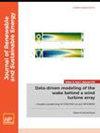Optimal capacity allocation and economic evaluation of hybrid energy storage in a wind–photovoltaic power system
IF 1.9
4区 工程技术
Q4 ENERGY & FUELS
引用次数: 0
Abstract
During the global energy crisis, a significant influx of renewable energy sources was connected to the power grid, resulting in adverse fluctuations. To address this challenge and simultaneously reduce environmental pollution, a hybrid energy storage system containing hydrogen energy storage (HES) and compressed air energy storage (CAES) are proposed. The system aims to reconfigure the energy storage devices by an economical means and effectively alleviate the volatility challenges by the large amount of renewable energy accessing. First, according to the behavioral characteristics of wind, photovoltaics, and the energy storage, the hybrid energy storage capacity optimization allocation model is established, and its economy is nearly 17% and 4.7% better than that of single HES and single CAES, respectively. Then, considering the difficulty of solving the complexity dimension, a carnivorous plant algorithm (CPA) is adopted to solve the model and accurately obtain the strategy of hybrid energy storage configuration in this paper. The running time of a CPA algorithm is 33.6%, 36%, and 55% shorter than particle swarm optimization, whale optimization algorithm, and firefly algorithm, respectively. Finally, the simulation analysis is performed by IEEE 33 node arithmetic. The results show that the network loss with hybrid energy storage is reduced by about 40% compared with that without hybrid energy storage. However, improving voltage stability and the economy is optimal by using configured hybrid energy storage.风电光伏系统混合储能优化容量分配及经济性评价
在全球能源危机期间,大量可再生能源接入电网,造成不利波动。为了应对这一挑战,同时减少环境污染,提出了一种包含氢储能(HES)和压缩空气储能(CAES)的混合储能系统。该系统旨在以经济的方式重新配置储能设备,有效缓解大量可再生能源接入带来的波动性挑战。首先,根据风能、光伏和储能的行为特点,建立了混合储能容量优化配置模型,其经济性分别比单一HES和单一CAES提高近17%和4.7%。然后,考虑到复杂性维数求解的难度,本文采用食肉植物算法(CPA)对模型进行求解,准确得到混合储能配置策略。CPA算法的运行时间分别比粒子群算法、鲸鱼算法和萤火虫算法短33.6%、36%和55%。最后,采用IEEE 33节点算法进行仿真分析。结果表明,与不采用混合储能相比,采用混合储能的电网损耗降低了约40%。然而,通过配置混合储能,提高电压稳定性和经济性是最理想的。
本文章由计算机程序翻译,如有差异,请以英文原文为准。
求助全文
约1分钟内获得全文
求助全文
来源期刊

Journal of Renewable and Sustainable Energy
ENERGY & FUELS-ENERGY & FUELS
CiteScore
4.30
自引率
12.00%
发文量
122
审稿时长
4.2 months
期刊介绍:
The Journal of Renewable and Sustainable Energy (JRSE) is an interdisciplinary, peer-reviewed journal covering all areas of renewable and sustainable energy relevant to the physical science and engineering communities. The interdisciplinary approach of the publication ensures that the editors draw from researchers worldwide in a diverse range of fields.
Topics covered include:
Renewable energy economics and policy
Renewable energy resource assessment
Solar energy: photovoltaics, solar thermal energy, solar energy for fuels
Wind energy: wind farms, rotors and blades, on- and offshore wind conditions, aerodynamics, fluid dynamics
Bioenergy: biofuels, biomass conversion, artificial photosynthesis
Distributed energy generation: rooftop PV, distributed fuel cells, distributed wind, micro-hydrogen power generation
Power distribution & systems modeling: power electronics and controls, smart grid
Energy efficient buildings: smart windows, PV, wind, power management
Energy conversion: flexoelectric, piezoelectric, thermoelectric, other technologies
Energy storage: batteries, supercapacitors, hydrogen storage, other fuels
Fuel cells: proton exchange membrane cells, solid oxide cells, hybrid fuel cells, other
Marine and hydroelectric energy: dams, tides, waves, other
Transportation: alternative vehicle technologies, plug-in technologies, other
Geothermal energy
 求助内容:
求助内容: 应助结果提醒方式:
应助结果提醒方式:


